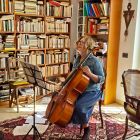Il Turco in Italia reviewed.
Rossinis musical invention throughout this sparkling comedy is always delicious and often sublime, with a wonderful array of those witty ensembles he so excelled in. The overture may not be one of his most inspired, but is typically very jolly and leads into a wonderful series of duets, trios, quartets, quintets and sextets, and the odd solo, which follow each other without break the whole way through. The skill of the singers is paramount for success, and here the Rome Opera House has done an excellent job in finding a team of mostly young singers, well up to coping with strenuous vocal requirements.
The action takes place in Naples, with many parallels in spirit and plot with Mozarts Cos fan tutte. The production, by Stefano Vizioli, is busy, with a perhaps excessive emphasis on complicated and restless movement by the chorus and principals all over the stage, and has been rather unconvincingly transposed into the 1920s instead of the more conventional end of 18th / beginning of 19th centuries. This does not work very well, chiefly because fascination with the Ottoman orient had by then died out, whereas in the earlier period there was an absolute curiosity about all things eastern, with members of European upper classes, such as Lady Hester Stanhope or Lady Jane Digby, ranging through the near and middle east, writing accounts of their travels or even, in the case of the latter, actually cohabiting with a sheikh in Anatolia. Sets and costumes are by Susanna Rossi Jost. The sets are economical, straightforward and very effective, with Vesuvius featuring always in the background to remind us where we are, and the costumes are exactly as you would expect from the 20s, apart from Selim the Turk, who is timeless.
Conductor Donato Renzetti takes the whole opera at a very smart pace, ideal for the rapidly developing action, and the orchestra responds well.
Carlo Lepore is Selim, the seductive Turk; it is a classic florid Rossini bass role, calling for agility and wit, both of which he has aplenty, together with a fine, manly stage presence, irresistible to the capricious Donna Fiorilla, who is the young Spanish soprano, Angeles Blancas Gulin. A superb actress, arch and flighty to perfection, with a strong and agile voice, she is a little ungenerous with her top notes. Most of her arias and the ensembles she takes part in could end in the thrilling high soprano notes that opera aficionados love, but she only pulls one out in the whole course of this piece. Don Geronio is another good Rossini bass role, and is sung with humour and pathos by Paolo Rumetz. Gregory Kunde gets through the perilous heights of Narcisos tenor parts with style, while Nadia Pirazzini is a fine Zaida, fiery and touching. Mario Cassio as the cynical Poet is excellent.
A really enjoyable evening, in which the fun and commitment by the singers far outweigh any niggles on the production.
Teatro dellOpera di Roma at the Teatro Nazionale, Via del Viminale 51, Rome
Tel. 06481601 www.opera.roma.it. 30 May 2006, further performances 31 May, 1, 3, 4 and 6 June 2006.
www.john-fort.com





















